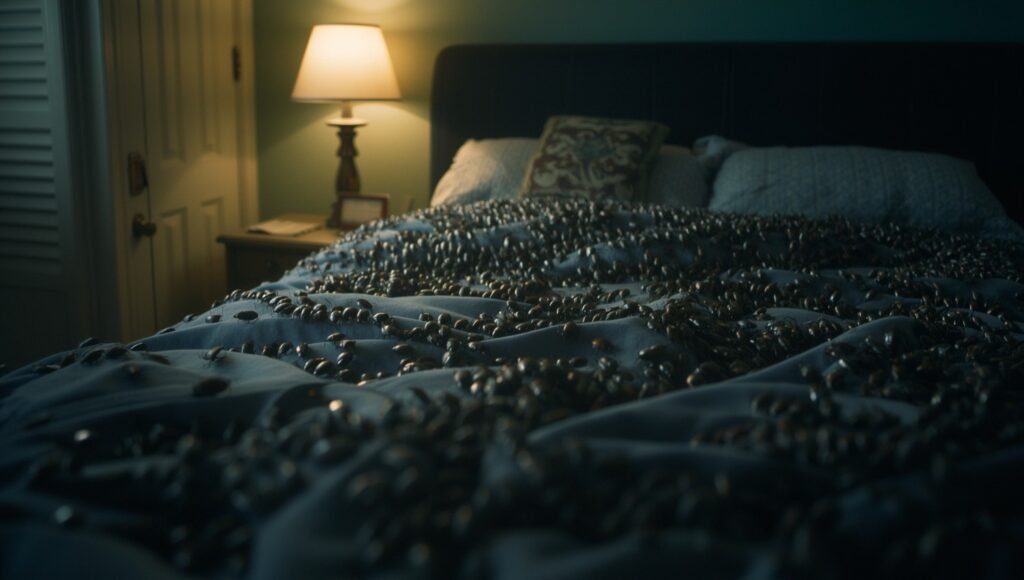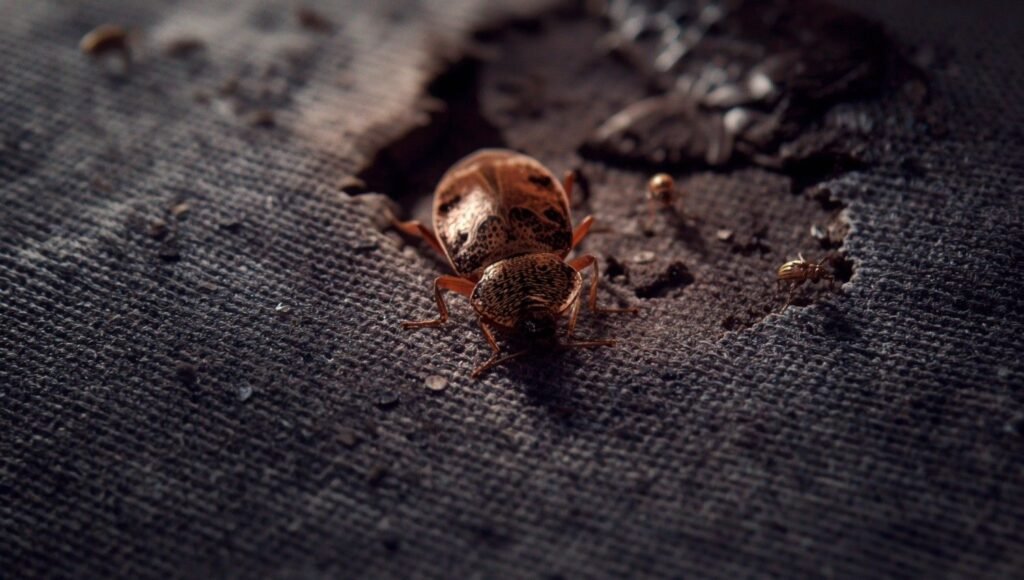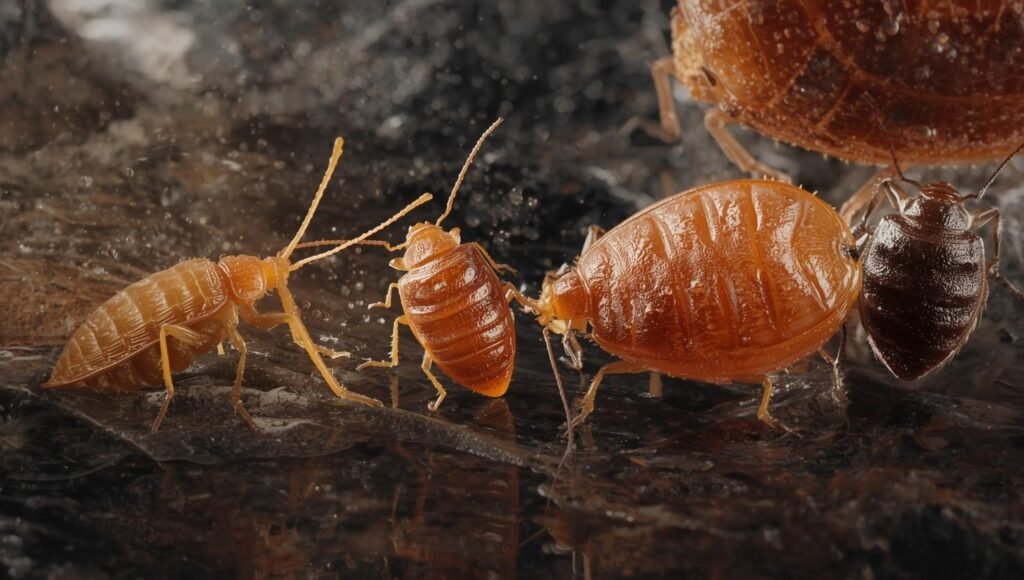Introduction
When I first discovered an infestation in my property, it began with small cracks in the boards near the drawers and under the mattresses. The pests were hiding quietly, and some unlucky slumberers in nearby rooms complained about a creepy sensation, almost like constant gnawing at night. I noticed tiny eggs tucked into pillows, linens, and even behind zips, and the infested areas kept getting worse. These insects can spread so fast that one day your space feels safe, and the next it feels lost to multiple infestations. I had to scrub the crevices with a stiff brush, but the fight was far from over.
Through experience, I’ve learned that only thorough care and consistent treatments make a difference. Cleanliness and regular sanitizing routines help, but some infestations require control from a trusted company. In hotels or living quarters, the risks are even higher, and without action, the problem only grows further. It is recommended never to ignore creepy signs, because once the bugs get happily settled, you’ll be stuck repeating the process and losing ground. Acting early makes it possible to rid your home of these pests before they take over the globe of your daily life, and keeps your health safe.
How to Get Rid of Bed Bugs in Australia?
In my own household experience, I’ve seen how bugs can be both resilient and resistant, making them some of the most common pests Australians face. To prevent a large infestation, you need to stay vigilant and pick up on early signs—like marks on bedsheets or unusual bites. In one case, I noticed a few buggers crawling near a bed, and with quick action, I managed to stamp out the issue before it grew beyond control. Using methods that involve a step-by-step routine can make the process less difficult. Even a few practical pointers, like learning to know where they hide or how they move, will help you get started.
Of course, some problems go beyond simple fixes, and that’s when professional assistance becomes essential. A trained team knows how to handle stubborn infestation cases with proper extermination. I’ve seen people try with only elbow grease and still struggle, but a professional touch can quell what feels like the hardest battle you’ll ever face at home. Whether you’re tackling them by hand or hiring experts, the key is to remain consistent, follow each step, and use proven methods. That way, you’ll not only rid your space of bugs, but also keep them out for good.

Step 1: Find the Buggers
The first thing I learned when dealing with bed bugs is that they can be notoriously hard to spot. A quick casual perusal often won’t help, as they hide in small spaces around apartments, hotels, and even hostels. If you look closely, there are telltale signs like tiny stains or unusual bites. I once stayed in a high-density block of living complexes, and just a few bugs turned into a significant risk for everyone. That’s why checking regularly when you travel or move into new places is so important.
Bed bugs often hitchhike from people’s belongings, animals, or even poultry, so it’s smart to stay alert during travels. In one case, I noticed them after close contact with used furniture that came from a friend’s place. There are a lot of ways they can get out of sight and spread quickly, so whenever you see suspicious spots, act early. Whether in a family home or shared complexes, the key is awareness—catching the problem before it grows into something far more significant.
Step 2: Know the Signs
When I had my first infestation, I didn’t realise that the small marks on my skin were actually from these rascals. You might notice red patches, itchy spots, or even blisters after nighttime bites. Some unlucky nights, you may sleep through and only later find tiny blood stains on your mattress or bed. These are obvious warnings, and ignoring them can lead to a growing population. If you see a bug skittering out from underneath the frame, that’s another clear spot to check.
In my experience, the symptoms can be confusing, but they’re rarely ordinary. A few ones may seem like an allergy, but a closer lookout often reveals waste marks or crushed insects along the seams. These pests are highly communicable, so it’s smart to double-check your whole body and bedding thoroughly. The cause of this problem is always the same—hidden bugs—and the sooner you act, the less you’ll lose in comfort and peace of mind.
Step 3: Isolate Problem Areas
When I first dealt with an infestation, I made the mistake of moving things around and only spread the bugs further. The right step is to look for visible signs in sofas, footstools, beds, and wardrobes, and then keep these items contained. Bed bugs hide in cloth-filled spaces like drawers, linen, or sheets, and even in baskets or hampers. Sometimes the edges of carpets or corners of houses show excrement or tiny larvae, which mark an active stage of the problem. The smell is another distinct clue—a musty, unpleasant odour that makes it easier to see where they hide.
I’ve seen people, and even my own dog and cat, bring pests from one place to another, so you cannot forget to check every corner. It can be difficult to manage alone, and in several cases, calling an exterminator with proper control methods was the only way forward. Still, I learned that using your own hands carefully, keeping spaces warm, and reducing clutter can slow them down. A lot of patience is required, but with close check and immediate action, you can limit the unrest these pests cause for people living in infested areas.
Step 4: Start with the Bedsheets
The first step I always take during an infestation is stripping the bed and removing all sheets, linen, and bedding. Put everything into a sealed bag before taking it to the laundry, so no bugs move into another room. Use a machine wash on hot temperatures followed by a full dry cycle, as both heat and cold extremes can kill pests. I once thought a moderate wash was good enough, but I learned quickly that only hot water brings real progress. After that, I wiped the frame and mattress with a non-toxic spray and a cloth, making sure every affected surface was clean.
Once the action of cleaning is done, I focus on storing everything properly. A clean container or store space is crucial because putting freshly washed items back into an infested area will undo all your work. This is the perfect opportunity to keep storing clothes and bedding in safe spots until the entire problem is solved. In one case, I even noticed bugstrying to thrive again soon after washing, so repeating the process and keeping things sealed is key. With each packing, washing, and wiping, you slowly push the infestation out, keeping your sleep safe from further trouble.
Step 5: Move onto the Bed
After the sheets are done, it’s time to give the bed and mattress full attention. I like to work methodically, using a nozzle for deep vacuuming so I can reach every corner. Once, I missed a few spots and those stragglers came back almost immediately, so now I always check and clean everything carefully. A spray helps, but I also consider adding a protector to trap any bug that tries to survive. If they can’t feed, they eventually starve. Sometimes, you may need to replace badly affected fabric or cloth, but often just cleaning in tandem with sealing is enough.
I also make sure to wash anything nearby, seal it in a bag, and then move it elsewhere in the house. By the final step, everything is sealed, wiped, and ready. This process takes long, but if you finish it correctly, you won’t leave any chance for pests to emigrate back into your room. In my experience, the moment you stay consistent and clean everything onschedule, those unwanted stragglers finally disappear.
Step 6: Go Through the Bedroom and Beyond
The room isn’t the only affected place; the whole house needs cleaning. I usually sanitise carpets, wipe down corners, and use steam for linens, curtains, and clothing. Vacuuming is part of the procedure, and even non-washable items can be handled with spray or damp wipes. Once, I ignored a little shelf, and the bugs multiplied in hidden clusters, so now I treat every area, even if it looks clean. Hot steam is efficient for killing both eggs and infants, and it works on most washable items.
To finish, I always take a shower after the process, because stray stragglers sometimes cling to you. It’s a simple but crucial step that keeps the life cycle from continuing. Whether you’re dealing with stuff that’s big or small, isolating affected items is the safest way. In my own battles, I’ve found that when you turn cleaning into a routine—wipe, sanitise, and use steam—the infestation loses its hold and you win back your space.
Step 7: Remain Vigilant
Even after the main cleaning steps are done, you must keep going with regular checks. Bed bugs hide well, and there’s always a chance a few eggs were missed. I learned this the hard way when I thought the job was finished, only to see them crawled back a week later. That’s why daily inspections of your mattress and furniture are a top contender for prevention. Vacuuming through each area again and again is never wasted time—it’s the only way to be free of those nasty pests.
It might feel like too many cycles of repeating, checking, and doing, but it’s needed. In my experience, the pests probably survive if you cut corners, so the rule is simple: always follow through until the first and final job is truly done. You’ll get results if you repeat as often as needed, even if it takes another week or two. Stay persistent, and you’ll push them back for good—no pests, no excuses, just a clean, safe home.

What Are Bed Bugs?
Bed bugs are small insects that feed on blood and are most active at night. These nocturnal creatures prefer to hide in dark places around your home, such as bedding, cracks in furniture, or folds of clothing. I once discovered them after returning from a trip, tucked into my luggage and later spreading to my bed. They can be hard to find because they are so tiny, but the ways they move and settle are pretty common—hopping from people to animals, and from one second-hand chair or sheet to the next.
The problem is that these pests adapt much too well. By bringing them unknowingly into your space, you give them a chance to multiply. They thrive in dry and warm environments, making it tough to notice them until it’s too late. In my own home, I realised that spotting them at the right time is crucial, because once they’re inside, removing them is not usually easy. They don’t care whether you keep things clean or cluttered; they’ll find a handy crack or crevice and settle in quickly.
What Are the Common Signs of Bed Bugs?
The first sign of bed bugs that most people notice is waking up with bites on exposed skin. Unlike mosquitoes, these insects don’t favour a single spot—they feast on any area they can reach. The bites may seem painless at first but can leave itchy marks quickly. In my case, the real clue was when I saw tiny traces and stains on my sheets and pillowcases. A musty odour or sweet scent from their glands is another giveaway, along with clusters of small eggs or shells hiding in seams or nooks of the mattresses and bed frames.
Other attributes of their presence include excrement that looks like rusty or dark patches on clothes, walls, or nearby furniture. Sometimes these marks are so subtle they resemble dust or a speck. I always tell friends to check every corner, especially the crannies and nooks around the bed. Seeing these popping spots can feel like a scene out of a horrormovie, but spotting them early makes the hard job of clearing an infestation much easier.
What Is the Lifecycle of a Bed Bug?
The life of a bed bug passes through several stages, from egg to nymph and finally into adults. A female can lay eggs every day, and after hatching in a few days or weeks, the nymphal forms begin to grow. They must take a meal of blood from a host before moving to the next stage. I’ve learned that feeding can take just a few minutes, but it is required for each phase to progress. These pests can live for months under the right warm conditions, and a matureadult will continue laying and feeding for the rest of its lives.
What makes them tougher is the anaesthetic in their saliva, which numbs the skin so you aren’t aware of being bittenwhile sleeping. This means the prey—usually people—don’t wake during a bite, making the feeding cycle even more effective. Over time, with several stages and different forms, they can obtain enough meals to grow upwards of hundreds in a single colony. The final stage is a fully grown adult, and the reason infestations feel endless is that the process can last for many months, actually repeating again and again.

How to Prevent Bed Bugs in Your Home?
One of the best lessons I learned after a holiday trip was to keep prevention routines simple yet thorough. Start with washing all clothing, linen, and curtains on a high heat setting in the machine and finishing them in the dryer—this kills eggs in just minutes. Always pack luggage in sealed plastic bags to stop bedbugs from hiding and transfer into your home. Once back, vacuuming your mattress, springs, and seams with a stiff brush helps remove pests and debris. If you’ve stored items outside or in the garage, check carefully before bringing them in.
I also recommend you encase your bed and box springs with tightly woven, zippered covers, which block pests from entering or escaping. Repair cracks in plaster, fix peeling paint, and use glue to seal fastenings or gaps—these tiny hiding spots are perfect for infestations. Clear clutter from surrounding areas, because it creates more hazards and hiding places. Dispose of old, infested items in sealed bags in the garbage so they can’t cause infection or spread. With these safe and precautions, you not only remove pests but also protect your health and living space for years.
How to Stop a Full Infestation?
When an infestation feels overwhelmed, you need more than just quick fixes—you need a clear treatment plan. Start with preventive measures like sealing crevices, cleaning springs, and vacuuming around baseboards, mouldings, and headboards. In my own home, I found that even beds, mattresses, and bedding can become breeding grounds for these crawlies if ignored. For severe situations, using insecticides such as pyrethroids, organophosphates, or carbamatesmay be required, but only when you carefully apply them by following exact directions. Misusing chemicals can be dangerous, especially around infant rooms.
If the problem continues, reaching out to a professional team can make all the difference. They know how to soak and treat hard-to-reach points effectively while ensuring your home remains safe. I once had to contact experts who provided the right options and pointers that helped me finally succeed in ridding the pests. Sometimes, having experienced people assist you is the wisest feeling, because trying to handle an infestation of this size on your own can be exhausting and risky.

Identify Whether Bed Bugs Are The Culprit
When I first had to confirm if bedbugs were the real culprit, the clues came from small spots, faint stains, and dark droppings on my mattress. These rust-coloured marks or crushed insects are an obvious indicator that pests are activeat night. Sometimes you’ll also see shed skins, tiny eggs, or clusters appearing along the lines of fabric seams or near furniture. A torch or torchlight can help you in checking those hidden areas, especially at odd hours when they are most active.
Another clue is the odour. A distinctive, sweet yet musty scent often lingers in a room where an infestation is occurring. If you’re sleeping and wake up with itchy bites on exposed areas, that’s another strong sign. The appearanceof these problems may seem typical, but they are not common irritations like mosquito bites. In my experience, once you start looking closely and checking regularly, you’ll quickly reveal whether your home is facing a permanent pest issue or just a temporary nuisance.
Step 1: Check for Bed Bugs
The presence of bed bugs can be tough to identify because they are nocturnal, fast, and often hide behind furniture. I remember the first time I saw the telltale signs; I almost went into panic thinking about these pests. At night, they are most active, making spotting the actual bugs tricky. Don’t just look at the bed surface—check carefully, even if it takes extra time. Using pesticides or cans right away without knowing the fact may only add to the difficulty of dealing with them. Stay calm, ensure you are thorough, and whip out a light to catch them in action.
Signs of Bed Bug Activity
One of the first things I noticed during an infestation were small reddish-brown spots on sheets. These came with itchy welts that appeared after a sleep meal. Discovering blood smears, shed exoskeletons, or bites on your home bedding is a clear sign of the problem. Often you’ll be noticing these when you’ve just woken, and they’re hard to ignore. Even though the marks look small, they are evidence that the bugs are happily feeding and enjoying your rest.
Bed Bug Hiding Spots
Bed bugs love pillows, mattresses, and linens, where they can hide in folds, seams, and crevices. I’ve found them hiding in furniture, upholstery, and even baseboards or crannies near electrical outlets. They can burrow into nooks, a box, or even luggage and backpacks, making them very elusive. Since they thrive in fabric, clothing, and bedding, regular inspections and prevention practices are essential. A professional control service may be needed if the infestationsbecome too challenging. Remember, these pests can stay close to humans and food sources, so keeping hygiene high and removing discarded items is crucial. Detection early on is the key to successfully eradicate these bugs before they spread further.
Step 2: Form a Plan of Attack – Start with Deep Cleaning
The first time I faced an infestation, I quickly learned that timing is everything. Work from the earliest stage by stripping sheets, blanket, and linens, then toss them straight into the washer or dryer on the hottest setting. This simple tacticcan kill many bugs before they multiply or reproduce. Be sure each bag you carry is sealed to contain the pests so they don’t spread around your home. I’ve even used alcohol to rub and sprayed down furniture, especially where clothingor hitchhikers may have traveled. A thorough cleaning with steam or vacuum is a workout, but it’s a successfulprocess if handled properly.
After you’ve washed and dried everything, make sure the area is cleaned and finished off with another absolute check. Apply heat or water where possible, and don’t forget to inspect recent travel items. Even a bed frame can be affected, so moved or cleaning every corner of furniture is part of the job. Once dried and contained, you’ll know you’ve startedthe right way. It’s tiring, but once you’ve rid your space of the worst, you’ll feel in control again.
What Kills Bed Bugs?
To fully tackle the problem, it’s important to understand what truly works. Many people rely on foggers, traps, and pesticides, but you need to use them correctly. Bed bugs can survive prolonged exposure unless the equipment and treatments are intensive enough. Some companies use heavy-duty tools and chemicals that are not always available to the public. At home, I’ve had good results with diatomaceous earth and glue traps, both special options that help against these hiders.
Remember, bed bugs are tough and can sustain themselves for long periods, so you must be armed with an understanding of their behavior. Concentrated chemical approaches can work but should be chosen with care, as only excellent control tactics will keep them from coming back. A mix of available over-the-counter products and widelyused remedies like earth powders or foggers can give you a fair chance. The trick is not just applying treatments, but knowing how to use them at the right moment to break their cycle and keep your bed and home safe.
Step 3: Try DIY Bed Bug Solutions
Many homeowners try to handle a bed bug infestation on their own with do-it-yourself methods. Whether it’s a small house or larger square footage, the results often depend on several factors like the severity of the problem, the presence of children or pets, and the knowledge you bring to the job. Without proper training, you might find it difficult to treat every area or fully remove the population of bugs. I’ve seen consumer products that claim to be effective, but their potency is often low compared to professional services. Still, with the right equipment, products, and approaches, you can compensate for the lack of professional support.
DIY treatments may provide convenience and can be specific to certain areas or times, but they’re rarely a permanent solution. In my own home, I learned to learn proper treatments and tactics to keep the bugs from spreading. From ridding unwanted pests in one particular room to preventing them from reaching other parts of the home, it’s a constant effort. The average results won’t always match professional services, but for some cases, they’re a good first step until stronger measures are needed.
Bed Bug Foggers
I once tried foggers at home, and while they seemed effective at first, the unpleasant odors lingered for hours. These aerosol bombs release a mist of insecticides designed to eradicate pests, but they don’t always reach hard-to-reachspots like inside a mattress. Bed bugs may survive in hidden areas, so repeated treatment is often required. The chemicals can be dangerous to inhale, and they pose risks of fire if the user doesn’t carefully handle them.
Intercepting the life cycles of bed bugs with foggers works only in conjunction with other treatments. They can killeggs, larvae, and hatching bugs, but several rounds are needed. Repeated use is hazardous because of the fumes and flammable elements. I always leave the house for a few hours while the fogger is sprayed to disperse the gas. Even so, some pests may remain, so foggers are best seen as part of a wider control plan, not a standalone cure.
Heat Treatments
Bed bugs cannot survive prolonged exposure to heating above 113 degrees. In my experience, this treatment is powerful but also expensive and sometimes time-consuming. You’ll need specific equipment to heat an entire roomor house, and the impact must be sustained long enough to kill every bug. Some people try to use a purchased onlineheater, but keeping the right degree is difficult.
These treatments work well for linens, clothing, or smaller items, but for larger areas, it’s a challenge. Bed bugs can enter a state of diapause—like hibernation—to survive cool conditions, but they will die once the elements reach lethal heat. Whether you’re dealing with a space in your home or just a mattress, heat is one of the most reliable kindof remedies, though it demands effort and cost.
Interceptor Traps
Bed bug interceptor traps are one of the simplest tools I’ve used. Placed underneath the legs of furniture like couches, beds, or a dresser, these small plastic trays trap pests trying to climb toward their host. By keeping them sealed inside, you can dispose of them safely in bags.
They’re an excellent way to monitor the severity of an infested area because the more bugs you catch, the more you know about the numbers left. Over time, you’ll see them dwindle, which gives assured confidence that other treatment options are working. Still, interceptors only stop the bugs from escaping or moving further, they don’t actually remove the problem. I use them as a rest and monitoring tool to lead my plan in the right direction, not as a final cure.
Will DIY Treatments Get Rid of Bed Bugs?
In truth, DIY methods are difficult when compared to a trained exterminator. Bed bugs hide in tiny crevices and seams, making them notorious and hard to cover every inch. Some tactics must be repetitive and consistent, since they can reproduce quickly and go through each stage of their life cycle. Without the right gear and chemicals, many attempts fail.
Still, I’ve found that DIY approaches can be effective if you remember to repeat processes and use all available knowledge. Whether it’s from a local store or a hardware shop, DIY treatments can rid some pests in a space, but results vary. Professionals are faster, with better training and access to protective equipment, but for smaller infestations, employing DIY steps can buy you valuable time before calling in an exterminator.
Step 4: When DIY Fails, Call a Professional Exterminator
Sometimes the sun sets on your own efforts, and no matter how much DIY you’ve done, the pests just won’t go away. At that point, you may feel exhausted and realize it’s time to eradicate the problem with expert help. A good planinvolves finding a professional company that can specialize in bed bug treatment. These experienced teams can tailor their approach to your situation, whether it’s a small home or a more difficult set of scenarios. They use advanced equipment and chemicals not available to the average consumer, giving you the chance to finally rid your space of unwanted pests. I’ve seen firsthand how a professional can quickly bring control where repeated attempts only failed.
Different companies offer different types of services, so choosing the right one is required. Some may focus on integrated pest control, others on chemical or heat-based treatments, but all aim to solve the situation more effectively than a DIY approach. While it might cost more up front, the results are usually quicker and longer lasting. From my own experience, calling a professional early can save a lot of stress and prevent the infestation from spreading beyond your home.
Chemical Bed Bug Treatments
A chemical approach to bed bugs can vary, but professionals often use both residual and contact insecticides to eliminate them. These treatments may come in liquid sprays that are carefully applied to baseboards, crevices, and other harborage spots where pests tend to hide. I’ve noticed that the efficacy of these methods depends heavily on following the correct protocol and ensuring every crack and surface is treated.
Because some populations develop resistance, experts may need to adjust their strategies and use a mix of methods. Safety is important, so these chemical treatments should only be done by trained, licensed professionals. Combined with vacuuming, heat, and other integrated pest management practices, this comprehensive choice often proves the most recommended way to tackle a stubborn infestation.
Heat Treatments
Professional heat treatments are another highly effective strategy. The process involves raising the temperature of an infested room to lethal levels, usually between 120–140 degrees Fahrenheit (49–60 °Celsius). Bedbugs cannot survive this, making it one of the most reliable options. However, it must be conducted by certified and trainedexperts with specialized equipment to monitor and maintain the desired level.
There are hazards like fire or structural issues if not done correctly, so safety is always emphasized. While it’s highlysuitable for whole-room treatments, it’s important to note that this method requires careful management and is best for serious infestations. From my perspective, heat works wonderfully when chemicals aren’t enough, but its effectiveness depends on ensuring every part of the space is evenly heated.
Fumigations
In rare cases, fumigation is used as a more extreme solution. Here, certified and insured technicians from trusted providers fumigate the home with specially designed insecticide gases. This method can eradicate bed bugs quickly and thoroughly, but it should never be attempted as DIY. Professional control is crucial, as the chemical process can be dangerous if attempted without the proper training.
Companies like Dodson, with many years of experience, have heavily invested in this method. They use tape and seal techniques to protect possessions while ensuring pests cannot survive the treatment. Although this scenario may sound intense, it’s often the most effective solution when infestations are severe. From what I’ve seen, fumigations are a safe and lasting option when conducted under the right control and supervision.
Prevent a Bed Bug Infestation From Getting Worse
When I first faced bed bugs, I learned that acting decisive is the only way to contain the issue before it spreads to all your belongings. Think of it like fixing a leak — if you don’t stop it quickly, the water will cause further damage. Using isolation techniques makes it much easier to stop bugs from climbing into new space. A simple step is covering your mattress with a bug-proof encasement; these covers are crucial in preventing an infected bed from becoming a bigger problem. I’ve seen how a barrier around the bed creates a safe space for sleep, as bugs can’t climb up once cups or interceptor devices are in place under the legs.
Be careful not to make the mistake of moving furniture or clothes to another room, as that only spreads the infecteditems. Instead, focus on containing them and confirm the problem stays in one box or space until you can fully treat it. Use special encasements or sealed covers for spring beds and other furniture, and make sure no fabric touches the floor or wall, which creates new ways for bugs to escape. With a quick, decisive action and the right barrier techniques, you can stop the spread and make the new problem much harder for pests to survive.
How To Get Rid Of Bed Bugs at Home?
At home, getting rid of bed bugs takes a systematic and thorough approach. Start by paying attention to your mattress, seams, and buttons, giving each side a stiff scrub or spray. A vacuum is useful for catching and dislodgingeggs, but it should be followed with appropriate encasement covers to prevent the pests from infesting again. Always follow instructions from the manufacturer of any product you use, whether spray or cleaning solution. In my experience, a complete cleaning often means multiple applications, from the initial pass to the final applying of treatments, ensuring every surface is covered and no eggs are left surviving. A new protective encasement designed for beds can help stop reinfestations and keep the space completely safe.
Clothes and Fabrics
Don’t forget clothes, linen, curtains, and accessories, as they can quickly spread bedbugs. I always place these items in sealed bags, then washed them at high Celsius degrees in a machine, or had them cleaned in another suitable manner. Even throws, towels, coats, and undergarments need this treatment to prevent further problems. A careful plan of collecting, taking, and laundering items ensures that nothing drops onto the floor during the process. Once cleaned and dry, store them in covers or bags to avoid reinfestation inside the room.
Furniture and Room Treatment
Your furniture and bedroom areas also need equal care. Use a vacuum with attachments to clean cracks, sockets, and woodwork, making sure fittings and switches are also inspected. In one case, I found bedbugs hiding behind paintingsand hangings, so removing and wiping them with a damp cloth and antibacterial spray was necessary. Don’t miss skirting boards, windows, or ornaments on the side or back wall. Every part, from books, folders, and files to freestanding furniture, must be vacuumed, cleaned, and properly stored. By repeating this process several times, you’ll increase the chances of spotting early signs and fully clearing the affected areas.
What DIY Treatments Can Kill Bed Bugs?
When tackling bed bugs at home, some DIY remedies are essential, though their effectiveness is often limited compared to professional methods. A steamer is highly recommended because steam penetrates deep into upholstery, mattress, carpets, and furniture, reaching eggs hidden in cracks or crevices. The high temperatures cause instant killing by dehydration, making it one of the most effective natural methods. I’ve also used diatomaceous earth, a fine powderthat scratches the outer shells of bugs, which slowly causes them to dehydrate and die. It must be applied thoroughlyaround entry points and affected areas, and then carefully disposed of after cleaning.
Some protective add-ons include lavender or tea tree oils, which are often reported to help in repelling bugs when diluted and spraying around infected spaces, though the scientifically proven performance is still debated. Baking soda has also been suggested as a natural approach, but it tends to work more slowly and with less success on largerinfestations. To boost results, combine laundry at hot settings, regular vacuum routines, and washing of all items, then keep infected furniture sealed or outside until properly treated. A solid plan with thorough cleaning, heat, and crucialrepetition can make these remedies part of a stronger bed bug treatment strategy at home.
Does Freezing Bed Bugs Really Work?
Using freezing as a method to kill bed bugs can be effective, but only under the right conditions. Bed bugs can survivein cool rooms, but they cannot handle extreme temperatures for prolonged periods. A household freezer can work if it reaches at least -18°C and keeps infested items inside for four full days. Place clothes, ornaments, or other delicateitems that can’t be washed into sealed plastic bags to stop bugs from escaping. Use a thermometer to confirm the temperatures stay consistent, because any warm gaps during exposure could allow survivors to live.
While this method works well for smaller objects, it’s not always practical for larger items like mattresses or electronics, which may suffer damage from condensation or liquid forming after thawing. Bed bugs can also enter a type of semi-hibernation state, which means shorter exposure won’t be enough to leave them dead. If used correctly, freezing can be a natural and safe way to prevent bugs from spreading further, but it requires handling with cautiousplanning and should be seen as part of a bigger household control plan rather than a quick fix.
Should You Remove Bed Bug Infected Furniture and Clothes?
When furniture or clothes are infected, deciding whether to keep or throw them away can be tough. Some items can be treated and saved with the right approach, while others may be too damaged or severely infested. For example, solid wood pieces are often easier to treat successfully, but soft furnishings like mattresses can be more challenging. In some cases, removal becomes the only effective option to prevent further spread in your home.
If you decide on disposal, it’s important to take responsible steps. Clearly mark the furniture or clothing as unusable, and consider slashing or breaking them so others don’t reuse them. While it might feel destructive or even wasteful, proper precautions and prevention methods are key to stopping bed bugs from moving into another home. Think of it not just as taking things out, but as a decision to protect everything else inside.
When Should Bed Bug Control Pros Be Considered?
If your infestation has gone beyond DIY tactics, calling exterminators is often the most reliable and cost-effectivestep. Professionals use specialised tools, professional-grade chemicals, and heating equipment that can penetratedeep hiding spots. Their knowledge helps them identify the full extent of the problem and develop a tailored plan for long-lasting success.
A good pest control company also offers follow-up visits to make sure nothing was missed, reducing the risk of failures. These experts understand which methods work best, whether it’s chemical sprays, heat at lethal temperatures, or a combination of both. Though hiring them might feel expensive at first, their expertise ensures more permanent results, saving you both cost and stress in the long-term.
How to Prevent a Future Bed Bug Infestation?
- Regular Inspection Routine
Check for droppings, shed skins, or small spots on your mattress, headboards, and bedside furniture at least monthly. Pay attention to seams, cracks, and crevices, since these dark areas are common hiding places. Even tiny unexplained marks on your bed or skin could be a clue, so always inspect thoroughly.
- Travel Safety Measures
After returning from a trip, inspect your luggage and keep it on sealed racks, never on beds or floors. Unpackdirectly into the washing machine, clean your clothes, and vacuum your suitcase before putting it away. In hotels, always check headboards, mattresses, and nearby furniture for signs before you settle in.
- Home Protection Steps
To reduce risks, vacuum frequently around furniture, legs, and walls. Use high-quality, bug-proof encasements on mattresses and pillows to block hidden pests. Seal any cracks or crevices, clear clutter, and install interceptor cupsunder the bed. These simple actions make your home a lot harder for bed bugs to infest.
- Second-hand Furniture Precautions
Always avoid picking up discarded or used furniture from the street. If you buy second-hand items, make sure they’re inspected, cleaned, and if possible, treated before entering your home. In commercial or residentialproperties like hotels, apartments, or care homes, professional monitoring with regular inspections, tracking, and early detection is invaluable. This extra vigilance helps in preventing infestations before they become established.
Don’t Let the Bed Bugs Win – Your Action Plan Starts Now
Bed bugs are resilient insects, but with the right strategies, they can be beaten. Whether you’re travelling, bringing in second-hand furniture, or maintaining your home, staying consistent in your inspections and remedies is crucial.
From my own experience, early intervention is always easier than tackling a full outbreak. By being vigilant, persistent, and willing to act sooner, you can successfully protect your space. Use both natural remedies and professional services when needed, and remember—bed bug control is not about panic, but about smart, steady action that keeps your home safe.
The Final Word
service, professionals, pestline, deserve, affordable, quote, invading, creepy, crawlies, removal, today, free, contact, live, bugs, home
FAQs:
- How do bed bugs typically get into a home?
The most common ways for bed bugs to get into your home are usually by hitching a ride in your luggage after you’ve returned from a trip or by being introduced through second-hand furniture, bedding, and clothing. - What are the telltale signs that I might have a bed bug infestation?
Several signs can indicate a bed bug problem. You might notice clusters of itchy bites on your skin that appear overnight. You may also find small blood stains on your bed sheets or pillowcases, or rusty-looking spots which are actually bed bug excrement. Keep an eye out for tiny, white eggshells often found in clusters, particularly around mattress seams and bed frames. In some cases, you might even notice a faint, musty odour.
- What are some steps I can take to prevent bed bugs from infesting my home?
To prevent bed bugs, especially after travelling, thoroughly inspect and scrub your luggage with a stiff brush, paying close attention to zippers and crevices, and then vacuum it. Wash all clothing from your trip on a hot cycle and dry it on the highest heat setting. Do the same with your bed linens. Regularly vacuum your bed and the surrounding areas, disposing of the vacuum bag immediately in an outside trash bin. Consider using plastic or tightly woven zippered covers for your mattress and box springs. Repair any cracks in plaster and glue down peeling wallpaper to eliminate hiding spots. Finally, reduce clutter around your bed.




